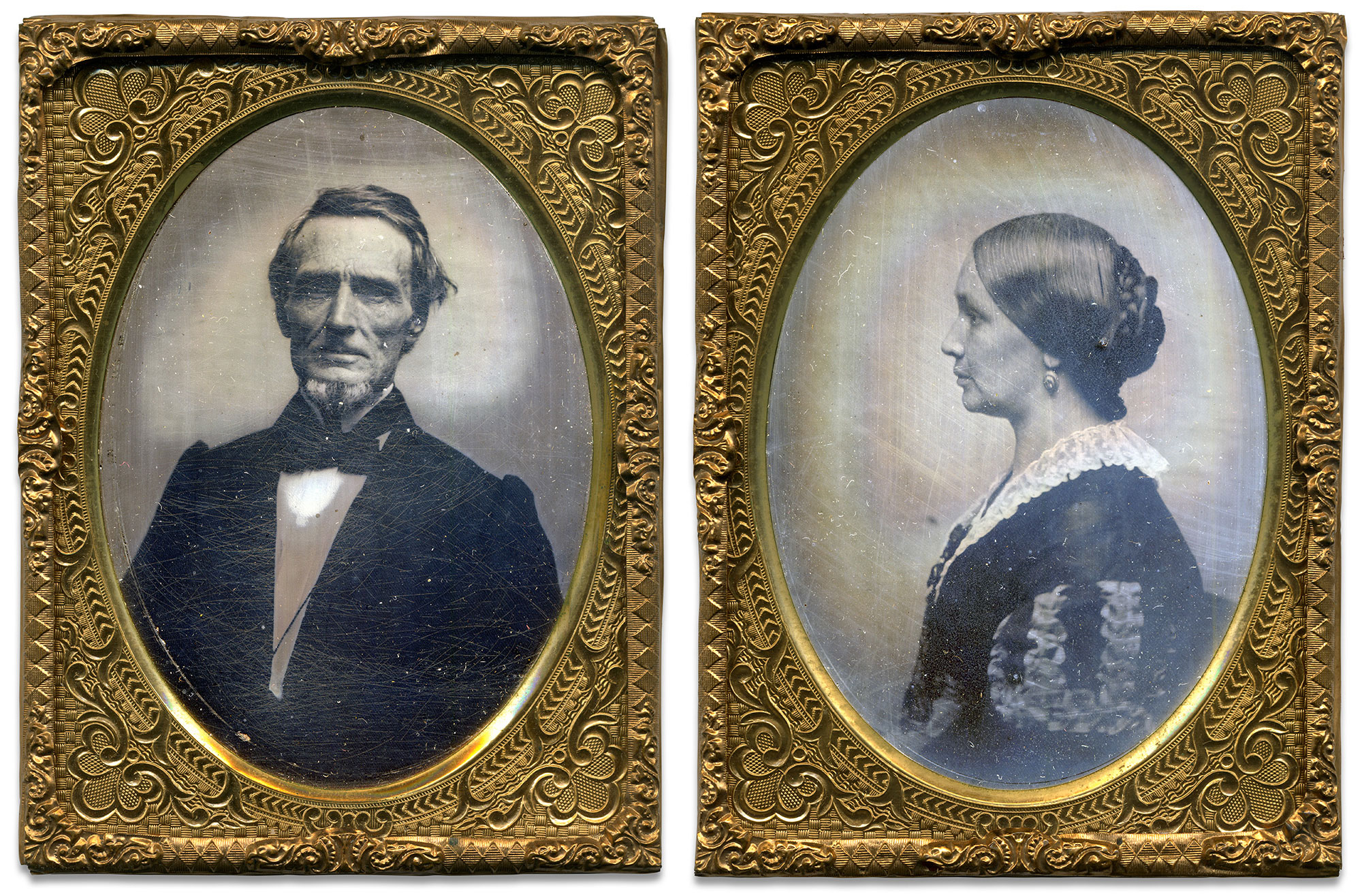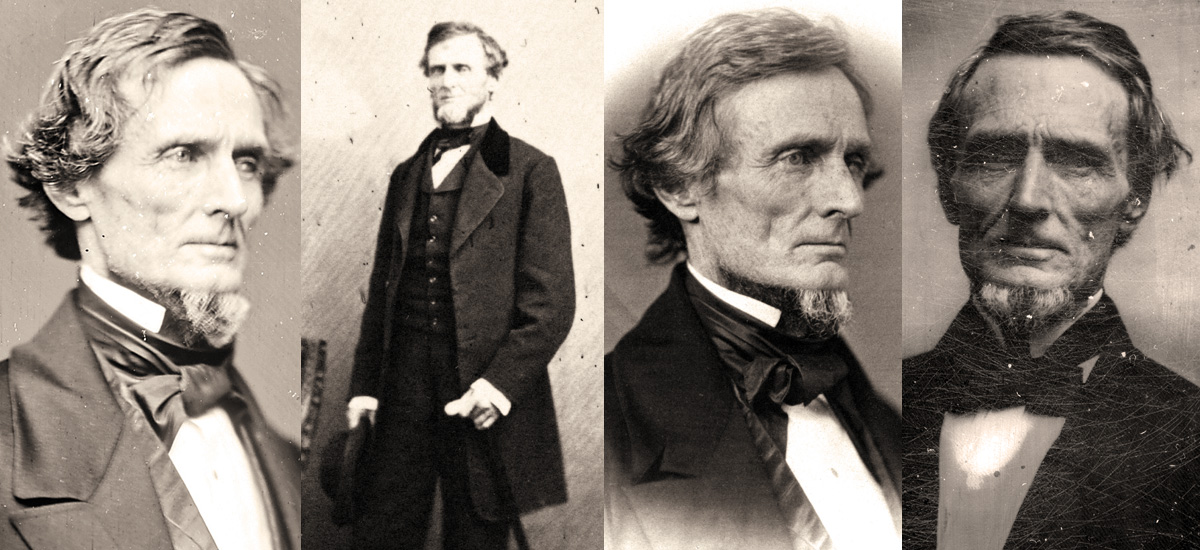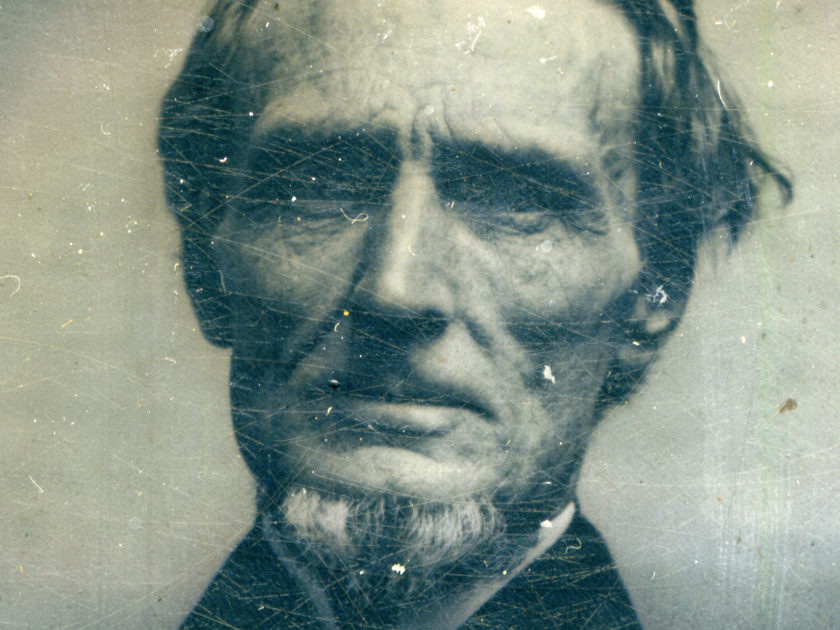By John O’Brien
In Washington, D.C. on Jan. 21, 1861, Jefferson Davis stood on the floor of the U.S. Senate and bid farewell to his colleagues. Two weeks earlier, his homeland of Mississippi had dissolved its ties with the Union, a move that effectively ended his senatorial career. In this final speech before leaving for the South, Davis defended the doctrine of secession and the sovereignty of the states. He also offered sincere apologies for the pain and suffering he might have caused his fellow senators in the heated and impassioned debates leading up to this grim moment.
The day proved the saddest of his life. Worn down by attempts to find a compromise to avert the current crisis and weighted down with stress and anxiety, Davis would soon leave the capital bound for an uncertain fate. His wife, Varina, would accompany him, equally distraught to leave their much-loved Washington.
These emotions are perhaps reflected in these unique and previously unpublished portraits of Jefferson and Varina Howell Davis, believed to have been taken during this tumultuous time. The images are quarter-plate tintypes, or melainotypes, attributed to Jesse Harrison Whitehurst, a veteran Washington photographer and a native of Virginia. His gallery on Pennsylvania Avenue was an easy walk from the Capitol.

Physical characteristics indicate the portraits were made at the same time. The brass mats and frames are similar, as is the texture of the back of the iron plates. Though the Davises may have visited Whitehurst’s gallery together, their different poses suggests the portraits were not thought of as a pair—Jefferson stares straight ahead and Varina in profile.
The facial characteristics of Jefferson Davis are comparable to three other images made about 1859. The best known and most familiar is the often-reproduced portrait credited to the Washington studio of Mathew Brady. The second view, far lesser known and rarely published, is a full-length portrait taken by a career soldier and amateur photographer, Montgomery C. Meigs. Georgia-born and loyal to the Union, Meigs would go on to a stellar career in the army, and help establish Arlington National Cemetery. A third view is a bust portrait of Davis taken by photographer James E. McClees or his assistant, Julian Vannerson. This likeness of Davis is one of 311 portraits included in a book, McClees’ Gallery of Photographic Portraits of the Senators, Representatives & Delegates of the Thirty-Fifth Congress.
The McClees and Vannerson portrait, a salted paper print, is the most comparable to the Davis tintype, because of the wide tonal range and sharpness of focus. Both portraits reveal Davis’ complexion in fine detail. His wrinkled brow, deep intersecting lines around his eyes and mouth, prominent vein protruding from his temple, high cheekbones, strong chin and angular contours of his face are evident. The lighting of the tintype makes a comparison of the eyes difficult, although a hint of his blue-gray pupils is visible.

One might be tempted to date the tintype and the paper print from roughly the same period. But a closer study of his facial characteristics, factoring in the differences in lighting, suggest the tintype was taken at a later date. There is also the question of expression. The McClees and Vannerson print captures a Davis who is intensely proud of his beloved Senate, and yet defiant as years of compromise and debate have tested, but not broken, the bonds of Union. In the tintype, by contrast, Davis appears in the grip of emotional strain. His expression may convey a fatigued leader struggling with the realities of his imminent departure from the Senate, desperately trying to make sense of the dissolution of the Union, and coming to terms with his role in precipitating the fracture of the country. Moreover, his belief that the impending war would be, in his words, “a long and severe struggle” is perhaps also reflected here.
All things considered, it is reasonable to hypothesize that Davis sat for this tintype during the stressful final months in Washington, in late 1860 or early January 1861. If the dating is accurate, this tintype of Jefferson Davis comes the closest in showing us how he looked on the eve of a conflict, which he had hoped to avoid.
The tintypes have an extraordinary provenance that traces to an unexpected source—U.S. Secretary of the Navy Gideon Welles.
After the fall of Richmond on April 2, 1865, the venerable secretary hoped to obtain a relic to mark the historic event. Specifically, he wanted a chair from the Confederate White House. But, he never mentioned the fact in his diary.
Welles was not alone in his desire for a piece of history, as evidenced by the wholesale removal of furniture and other items from the Wilmer McLean residence at Appomattox Court House after Gen. Robert E. Lee surrendered the Army of Northern Virginia to Lt. Gen. Ulysses S. Grant.
One officer present at Appomattox was Maj. Gen. Edward O.C. Ord, who left with the marble-topped table used by Gen. Lee during the surrender. He paid McLean $40 for the souvenir, which eventually made its way to the Chicago Historical Society.
Afterwards, Ord reported to Richmond to take command of the army of occupation headquartered in the city. Ord’s staff included Capt. Thomas Gideon Welles. The second of three sons of the secretary, Thomas was formally announced as a member of the staff of the Military Department of Virginia in general orders published on April 24, 1865.
Three days later, Thomas received a letter from his younger brother, Edgar, with his father’s request. Thomas replied the same day. “I received a letter from Edgar this a.m. requesting me to send you a chair from Jeff Davis House and am sorry to say that it is I am afraid out of my power to do so.” He had a good reason for his reluctance. Gen. Ord had turned over the house to Maj. Gen. Henry W. Halleck, who had been given command of the Military Division of the James. Thomas added that he was planning to leave the next day.
Despite his misgivings, Thomas managed to procure a pair of side chairs from the house. How he secured the chairs is not known. He may have approached Maj. Gen. Halleck or a member of his staff with a request. Or, perhaps, he talked his way past the guards and came away with them. Whatever the sequence of events, the chairs remained in the family well into the 20th century. They were acquired by the Museum of the Confederacy in 1985.
The tintype of Jefferson Davis marks a unique moment in the history of our nation.
Thomas may have picked up the Davis tintypes at the same time he came into possession of the chairs. In 1980, five years before the chairs returned to Richmond, I acquired the images from a dealer acting as an agent for descendants of the Welles family.
The tintype of Jefferson Davis marks a unique moment in the history of our nation. North and South were perched on the precipice of an ordeal that cost dearly in blood and treasury. Davis succeeded in holding his people together long after they had become too weak to continue the struggle. His energy and determination did much to enable a country with inadequate manpower and materials to fight an epic war against a powerful foe. Though final defeat diminished his reputation for leadership, many regarded him as a hero. A few years after the war, Gen. Lee observed, “If my opinion is worth anything, you can always say that few people could have done better than Mr. Davis. I know of none that could have done as well.”
Davis would later admit that though secession had been impractical, it was not wrong constitutionally. During his final years (he lived to 1889), he urged the South to accept the restoration of the Union and look ahead to a bright future.
In 1978, President Jimmy Carter signed a bill that restored full rights of citizenship to Davis. In his official statement, Carter noted, “Our Nation needs to clear away the guilts and enmities and recriminations of the past, to finally set at rest the divisions that threatened to destroy our Nation and to discredit the principles on which it was founded. Our people need to turn their attention to the important tasks that still lie before us in establishing those principles for all people.”
John O’Brien of Charles Town, W. Va., is a retired journalist and historian from the University of Connecticut, and a contributor to MI.
SPREAD THE WORD: We encourage you to share this story on social media and elsewhere to educate and raise awareness. If you wish to use any image on this page for another purpose, please request permission.
LEARN MORE about Military Images, America’s only magazine dedicated to showcasing, interpreting and preserving Civil War portrait photography.
VISIT OUR STORE to subscribe, renew a subscription, and more.

